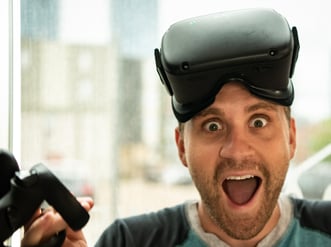Virtual Reality is the New IMAX for Science Centers and Museums
Posted on: 2021-01-20
Science centers and museums have an incredible opportunity in virtual reality. The technology opens up amazing and intuitive new ways of storytelling, entertainment, and education — in fact, the potential role of science centres in pioneering and sharing this technology with their visitors mirrors the role they played in early adoption of IMAX.
In a world about to recover from COVID-19, science centers and museums will need to reconnect with their communities. The time is right to bring VR tech onboard to play an important role in this work.
IMAX and Science Centers
People think nothing of going to see a blockbuster movie in IMAX these days. But if you've been with a science centre for a while, you'll especially know how that wasn't always the case.
IMAX is a technological innovation that began EXPO '67 in Montreal. Through experiments with projectors, the Canadian filmmakers came up with a way to combine nine projectors to create an enormous high quality image. It was not until 3 years later that the organization was formed and a product was shown and made available.
And which organizations signed on first? Science centers have long been a vital resource for communities as for many, this is the most accessible way to experience new technology. Science centres custom-built theatres just for IMAX, where audiences enjoyed more than a decade of fantastic documentaries before Hollywood started to think about it.
History of Virtual Reality
The idea of replicating the feel of the real world through more than just flat images also goes back a long way — all the way back to the 1800 with stereoscopic views of two images.
But in the more modern sense of donning a headset, there have been a number of releases of headsets and devices for commercial use in the 70s, 80s, and 90s. But It was not until recently, 2016, that the commercial and household technology has started to grow and become more adopted in its use.
Even so, virtual reality remains a relatively expensive investment if you want to go beyond the limitations of stationary VR. Just like being the first to bring IMAX to their communities, science centers and museums have the opportunity to be the first to bring fully immersive, free-roam virtual reality experiences to their communities.
Value of Virtual Reality for Science Centers

Virtual reality has a lot of value to offer science centers and museums.
Immersive Storytelling - Virtual reality transports users into other worlds in a way not possible to create with physical displays and props. Instead of experiencing worlds passively, virtual reality encourages people to feel free to walk around and interact with objects — viewing the scene from any angle they choose.
Programming - Birthday parties, educational exhibits, venue rentals — these are all practical examples of how science centers can deploy virtual reality in their facilities. The technology is intuitive enough for kids and adults alike that these activities require minimal supervision and guidance. It really is as simple as helping them with a headset and handing them controllers.
Cost Sharing - With IMAX, after the screens were in place, there was the separate issue of content. Some centers formed new organizations to fund new movies for the IMAX format and licensed them out to lower income locations to bring about a content boom which benefited the entire industry.
The same can be applied for virtual reality. While there are compelling content experiences already available, as this technology grows, there is the opportunity for organizations to examine together what sorts of content could benefit them all as it grows. And unlike physical displays (but just like with IMAX movies), once a new piece of content is available, it's available immediately, in the same space as all the others, with no additional setup time.
Current Use Cases
The Peterson Automotive Museum is a great example of virtual reality technology being used to take a stationary object, a car, and bring it to life. This video describes and shows the experience and how the technology provides value to the users and the museum.
At the Ontario Science Centre they needed a way to keep the attention of a younger audience. They accomplished this using virtual and augmented reality. Terracosm, a science fiction educational game, takes kids to alternate universes to learn about the laws of science via each experience and location.
The Natural History Museum partnered with broadcaster Sky to develop an educational experience allowing visitors to hang out with none other than Sir David Attenborough. For those of us not fortunate enough to meet the man in person, the virtual meet sounds like amazing way to learn more about a well-loved figure and his work.
Let Us Be Your Virtual Reality Guide.
At vrCAVE we push the boundaries of entertaining and educational virtual reality content. If you would like to learn more on how virtual reality works and how it can be used at your location please view our free educational webinar or reach out!


